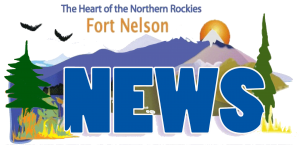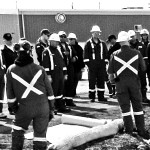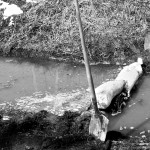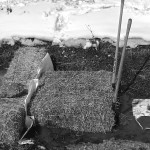WCSS conducts oil spill dry land clean-up exercise
- Representatives from approximately 15 companies attended WCSS’s dry land oil spill training session on April 29th. A mock oil spill was replicated in the drainage ditch near the water treatment plant, and participants broke into groups to demonstrate what to do in the case of a real oil spill.
- Sandbags block the flow on this inverted weir, with piping under the water to enable water to flow through. Oil would remain upstream of the dam. Photos by Kathy Smith
- Water passes through the hay bales, while the bales absorb debris (which would be oil in a real spill). The water on the right side after filtering is noticeably cleaner than what is trapped on the left side. Hydrocarbon absorbent pads that float on top of the water are also shown.
By Kathy Smith
Since 1972, Western Canada Spill Services Ltd. (WCSS) has been helping to ensure that the petroleum industry is in a state of preparedness for oil spill recovery. Part of the BC Oil and Gas Commission mandate is that all producing companies must have a spill response plan within their emergency response plan. Companies participate in an exercise each year to train their workers in safe and effective oil spill response.
Oil spill recovery and containment units are available to all member companies of WCSS, and the co-operative strategically places equipment all over western Canada that is suitable for specific logistics and operations in each area.
WCSS holds annual training sessions, and on April 29th Fort Nelson hosted a dry land spill response exercise. Following in-class instruction at the Woodland’s Inn, participants went to the ditch by the water treatment plant for practical exercises. Among several companies represented, Fort Nelson Fire Rescue attended. The fire department is affiliated with the Provincial Emergency Program (PEP), and firefighters assisted in the training by adding water to the ditch to simulate oil coming down the ditch toward participants.
Suncor Energy’s Don Brown is the WCSS Area Chairman in Fort Nelson, and he helped to organise the event. Brown says, “Our instructor, Trever Miller is the Response Coordinator with SWAT Consulting Inc. He has worked on many large oil spills like the Detroit Enbridge spill as well as in the Gulf. At the exercise we had four groups set up stations to learn some of the initial steps in the containment and recovery process. After water was added to the ditch, the first stage was to block off the culvert to try and stop everything from coming down.
“The next stage was putting in an inverted weir; basically an earthen dam with some pieces of pipe in it. The idea is to allow the oil to float up to the surface, while the water runs along the bottom and goes down the creek. You need enough pipe in the dam to allow water to keep moving and trap the oil. The stage after that was a filter system we made with hay bales. They will actually absorb a lot of oil, and they’ll be good for about a day before changing them. Straw or dried grass can be tied up and used as well. It holds the oil back and allows most of the water to slip through,” says Brown.
For the final stage of picking the sheen up off the top of the water, a hydrocarbon absorbent mat that lays flat on top of the water can be used. It picks up hydrocarbons like oil, diesel fuel, condensate, and more. Floating booms are also used. Following the initial steps, vac-trucks and tanks are used.
In this region, oil is primarily found in the ISH field past Yo-Yo and Sierra, where oil is piped to Alberta. Some lighter oils are trucked to Fort St. John. Brown says one of the worst case scenarios affecting the immediate area could be an oil tanker roll-over; “The volume isn’t going to be as crazy as Pine River where there were millions of litres spilled, but it could be hundreds or thousands.”
Annual exercises by WCSS familiarise workers with the equipment and how to use it. Fort Nelson’s sea can holds about 600 feet of boom with pumps, skimmers and other equipment to contain or recover oil and fuels. The custodian of the sea can is Clean Harbors and they maintain the equipment and make sure it’s ready to go. Fort St. John has a 40-foot regional trailer, and a very powerful barge that can carry six quads and ten people. “Hopefully in training year after year we get different people, so more of us know what to do in case of an incident,” says Brown.
“Last fall we did a full blown river exercise where we actually had the boats out with booms, pumps, and an open top tank that you can put water and oil into. We have two muskrats in town which have small outboard jet motors – you can go to a recovery site or bring equipment up-river to set up your containment at a good spot – you set it up so if you do have product coming down river or a creek you can contain it. We’ve had equipment here for over 10 years and it has gone out a few times. Nexen had it on-site last year when they were barging things across the Fort Nelson River, just in case there was a problem, so they wouldn’t have to truck it out from two or four hours away.”
Brown says WCSS did an ice exercise on Parker Lake a few years ago – they don’t use actual oil, though they have contained pop corn and ping pong balls. “We plan the agenda for the following year in December. I’ve been trying for some time to have a swamp exercise because we’re pretty swampy around here, so we’re just trying to locate property. Another could be a produced water spill (salt water used in oil and gas production). There’s been more than one incident of pipeline leaks here and that’s typically salt water.”
WCSS’s Area C, E & T Administrator, Gail O’Neill, coordinates the training exercises. She wants to remind members to attend the exercises and conduct quarterly checks on the WCSS website. There they will find Contingency Manuals, and updated information. Also it is important for member companies to send their updated information, such as changes to their contact info.
O’Neill can be reached at: gail.wcss@gmail.com, or cell (250) 261-9163.




 Follow
Follow



Recent Comments